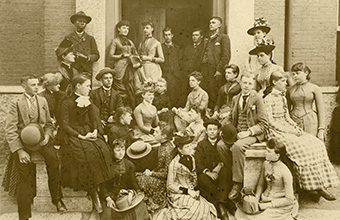College of Arts and Sciences Newsroom

Federal Humanities Funding
The University of Dayton received two National Endowment for the Humanities grants totaling $70,000 to support the development of interdisciplinary programs and curricula related to medical humanities and an influential African-American writer who called Dayton home.
One $35,000 grant will help the University and its community partners develop new curriculum and experiential learning opportunities for undergraduate students focused on the life, works and legacy of Dayton native Paul Laurence Dunbar — a late 19th and early 20th century poet, novelist and playwright who was one of the first African-American writers to establish a national reputation.
The other grant supports development of an undergraduate certificate in Humanities and Health Connections at the University. The certificate is intended for students majoring in degree programs in both the College of Arts and Sciences and the School of Education and Health Sciences. It will allow students interested in the health sciences and medicine to explore the role of the humanities as a central component of their education.
The University’s projects are two of 23 funded this year by the NEH Humanities Connections program that will allow undergraduate students at two- and four-year colleges and universities across the country to develop the intellectual skills and habits of mind that the humanities cultivate. Funding for the 23 projects totals $1.3 million.
Both University of Dayton projects start this summer and are funded for one year.
“These awards demonstrate that there really is public interest in humanities education and research,” said Jennifer Speed, College director for external funding and strategic resource development. Speed, also a research professor of religious studies, is a co-project director on the Dunbar project.
Funding for the NEH Humanities Connections program is highly competitive; the NEH only funds about about 11 percent of requests. In its first competition in 2017, the program received 189 applications and made 18 awards.
“For UD to receive two awards in the same competition, within the same program, speaks to the innovative humanities scholarship and teaching at the University,” Speed said.
Both projects touted the strength of the University’s Common Academic Program (CAP) in their funding proposals. The foundation of a University of Dayton education, CAP emphasizes humanities learning for all undergraduate students, regardless of their major, and examines the methodologies of multiple academic disciplines to help students understand the importance of integrating knowledge within and across disciplines.
“Our Common Academic Program enables faculty to come together and create extraordinary courses and meaningful learning experiences for everyone involved,” said Michelle Pautz, assistant provost for the Common Academic Program. “These grants will enable students to bring together various disciplinary perspectives to explore the life and legacy of Paul Laurence Dunbar, and to blend the humanities with the natural sciences.”
The Dunbar project’s goal is to develop new and revised courses that explore the breadth of the writer’s life, context, works and influence. Dunbar (1872-1906) was published in such journals as the Atlantic Monthly and The Saturday Evening Post, and was read by both blacks and whites in early 20th-century America.
The project will introduce digital humanities tools to both educators and students as a way to broaden engagement with historical materials. It also will develop new experiential learning opportunities that make use of Dayton’s rich collection of Dunbar materials, artifacts and locations, including the Paul Laurence Dunbar House, the first state memorial in Ohio to honor African-American history.
“By exploring these intersections of people, places and objects, we can better understand and appreciate the human experience,” Speed said.
Her co-project directors are Minnita Daniel-Cox, assistant professor of music, and Ju Shen, assistant professor of computer science.
Daniel-Cox developed and launched a Department of Music website to showcase and preserve musical presentations of Dunbar’s works. The Department of English also has a website dedicated to Dunbar’s literary archives, including performances of his poems by Professor Emeritus Herbert Woodward Martin.
Dunbar project partners include Dayton Metro Library, the National Park Service, Dayton History and Saint Louis University’s Center for Digital Humanities.
The Humanities and Health Connections project seeks to expand the connections between humanities disciplines — including anthropology, English and history — and biology and health sciences. The proposed certificate would provide students with opportunities in interdisciplinary research, community-based experiential learning and integrated methodological approaches to help them better understand and respond to the human experience of health and medicine.
The NEH grant allows the University to create a transdisciplinary program that puts the humanities at the center of health sciences studies, said Caroline Merithew, associate professor of history, who is a co-project director on the project with Carissa Krane, professor of biology.
“The grant means students with the certificate will move out into the world with both technical skills and compassionate understanding,” Merithew said. “It also showcases the University’s leadership in education for the 21st century, highlighting our institutional belief in both disciplinary integrity and interdisciplinary possibilities.”
The National Endowment for the Humanities is an independent federal agency created in 1965. It is one of the largest funders of humanities programs in the U.S.
- Dave Larsen, communication coordinator, College of Arts and Sciences
Photo at top courtesy of Special Collections and Archives, Wright State University. Paul Laurence Dunbar is in the top row, first from left.
